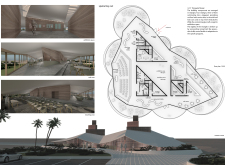5 key facts about this project
Flamingo Harbour is located about an hour's drive from Abu Dhabi, near the Al Wathba Wetland Reserve. The facility serves as a space for studying wildlife while highlighting traditional Arab architectural principles. Its design draws on five key concepts: the ziggurat, the oasis, the nomad tent, the windcatcher, and rammed earth walls. Together, these elements combine purpose and meaning, reflecting both cultural heritage and modern requirements.
Ziggurat
The structure features three ziggurats with triangular bases, symbolizing humanity’s pursuit of the heavens. Each ziggurat has specific functions. The lower parts contain service areas, while the middle sections offer lookout points. At the top, windcatchers enhance natural ventilation. This design effectively uses passive cooling strategies to create a comfortable environment.
Oasis
The landscaped oasis provides an educational garden that showcases various local and foreign plants. This area allows visitors to learn about desert biodiversity while enjoying shaded spaces. Arranging plants near the glass façade helps control sunlight. It reduces heat and improves comfort, particularly during the low-angle sun in the mornings and evenings.
Nomad Tent
The design reflects qualities of a nomad tent by allowing flexible and open spaces. This adaptation makes the layout suitable for various activities and enhances visitor interaction. The airy configuration promotes different educational experiences within the museum's environment, encouraging visitors to explore and engage.
Windcatcher and Rammed Earth
Windcatchers serve as a way to cool the interiors naturally, showing a commitment to sustainable practices rooted in cultural history. The choice of rammed earth as the construction material adds strength and connects the building to local architectural traditions. This material choice also provides a tactile quality that harmonizes with the surrounding landscape.
Large glass panels create connections between indoor spaces and the natural environment outside. These windows invite light and bring views of the wetlands into the design, enriching the visitor experience and creating a tranquil atmosphere.






















































